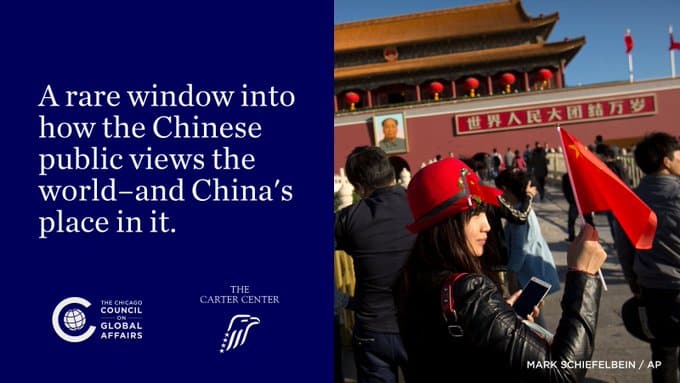REPORT: Finding Firmer Ground: Cold War Case Studies and Chinese Perspectives
- Opinion
 Olivia Moody
Olivia Moody- 03/19/2024
- 0

The Carter Center China Focus is pleased to announce the publication of its fifth issue of the Finding Firmer Ground report series. This latest issue, titled “Finding Firmer Ground: Cold War Case Studies and Chinese Perspectives,” details how a nuclear war between the U.S. and China can be avoided, utilizing the Cold War analogy as a starting point. The authors draw on these Cold War case studies and as well as Chinese perspectives on CBMs to inform policy recommendations for the modern Sino-U.S. nuclear relationship.
To download a full copy of the report please click here. Find previous reports in the Firmer Ground series here. The executive summary of the report, written by China Focus intern Olivia Moody, can be found below.
Introduction
Since the establishment of diplomatic relations between the U.S. and China in 1979, the bilateral relationship has experienced periodic declines in trust and disruptions in regular communication. Scholars are increasingly concerned that persistent tensions, driven by competition over technology and trade, coupled with more immediate strains such as the Trump administration’s confrontational approach and the COVID-19 pandemic, have heightened the volatility of U.S.-China relations to an unprecedented degree. Given that both the United States and China are among the nine nations worldwide that possess nuclear capabilities, analysts have also characterized this current phase in U.S.-China relations as a “New Cold War”.
Taking up this analogy to the U.S.-U.S.S.R. relationship during the Cold War, this report analyzes strategies for averting a possible nuclear conflict between the U.S. and China.
For example, the Cuban Missile Crisis of October 1962, a pivotal moment of direct confrontation between the United States and the Soviet Union, marked the nearest approach to nuclear warfare in history. Recognizing that nuclear war could lead to catastrophic global consequences, maintaining and enhancing nuclear risk reduction has remained a paramount objective for global powers. It was not until after this crisis that substantive nuclear risk reduction efforts took hold between the U.S. and the Soviet Union. However, early-stage confidence-building measures (CBMs) were instrumental in swiftly de-escalating the crisis and fostering a durable, stable nuclear relationship. This report investigates how Cold War-era CBMs might be adapted to the U.S.-China relationship, offering close consideration considering Chinese perspectives on such measures.
Methodology & Approach
To investigate the efficacy of Confidence Building Measures (CBMs) in reducing nuclear tensions, the authors gathered data through expert interviews, historical documents, news reports, academic studies on military culture, and public declarations by Chinese and American political and military leaders. The study focuses on three specific CBMs: dialogues, Direct Communication Links (DCLs), and Nuclear Risk Reduction Centers (NRRCs). These measures were selected for their effectiveness during the Cold War, their applicability to current international relations, and the valuable lessons they offer for U.S.-China nuclear relations. While insights from U.S.-Soviet Cold War CBMs are instructive for navigating today’s “New Cold War” with China, the authors note significant differences between historical and current dynamics. Consequently, recommendations for implementing these CBMs are tailored to contemporary Chinese views on CBMs, the current U.S.-China equivalents, and existing infrastructures that support these measures. As foundational measures, these CBMs can serve as initial steps towards a comprehensive, long-term de-escalation strategy.
Status Quo Nuclear Relations
The term “New Cold War” underscores the distinctive positions and operational frameworks within the U.S.-China nuclear relationship. Since becoming a nuclear power in 1964, China has adhered to a “No First Use” (NFU) policy, asserting that it will not initiate a nuclear strike but reserves the right to respond with nuclear force if attacked. This retaliatory capability is intended to counteract what China perceives as the dominance of established nuclear states, and has seen significant advancements, notably in early warning systems that could potentially enable a pre-emptive response to nuclear threats. These developments have heightened concerns over possible accidental or deliberate nuclear escalation. Notably, predictions by the Pentagon suggest that China could increase its nuclear warheads fourfold by 2030, a projection that has intensified U.S. concerns regarding the authenticity of China’s NFU policy and the implications for regional stability.
The expansion of CBMs in the U.S.-China context has been constrained by each country’s views on the other’s nuclear strategies. The United States has not formally acknowledged a state of mutual nuclear vulnerability with China, a stance that frustrates China given its perceived capacity for assured mutual destruction. This U.S. position is perceived by Chinese officials as both disrespectful and threatening. Conversely, China has often resisted international arms control agreements that demand transparency, arguing that it requires assurance of its safety through unilateral U.S. transparency. This mutual mistrust underscores the challenge in establishing effective CBMs, despite a general consensus on the need for de-escalation and nuclear disarmament. Nonetheless, CBMs have been sporadically implemented in the U.S.-China relationship, reflecting a complex interplay of agreement on principles and divergence on operational details.
Confidence Building Measure #1: Dialogues
Dialogues serve as forums where members of the general public, experts, and government officials from various countries engage in ongoing communication to forge enduring relationships. These can encompass conferences, educational exchanges, and tourism. In the realm of Confidence Building Measures (CBMs), dialogues are categorized into three tracks: Track 1 involves official government-to-government interactions; Track 2 encompasses entirely non-governmental exchanges, often unofficial; and Track 1.5 comprises a hybrid of government and non-government participants in generally unofficial settings. This study primarily focuses on Track 1.5 and Track 2 dialogues.
The 1958 U.S.-Soviet Cultural Exchange Agreement facilitated a broader scope of personal and institutional exchanges, exemplifying the strengths of dialogue-based CBMs. This led to further initiatives like the Dartmouth Conference, which has convened 145 times since 1960. The biannual meetings between U.S. and Soviet experts not only nurtured lasting relationships across divides but also cultivated an “epistemic community” that helped facilitate Track 1 discussions among hardened leaders. This community played pivotal roles during crises such as the Cuban Missile Crisis. The most significant lesson from this CBM for potential U.S.-China initiatives is its flexibility and resilience, allowing for open discussions on a range of issues, even amidst deteriorating diplomatic relations.
This potential was partially revealed by the Beijing-Hawaii Dialogues which existed between 2004 and 2019. However, the Beijing-Hawaii Dialogues did not achieve similar longevity or impact. Structured similarly to the Dartmouth Conference, these dialogues faltered due to several factors, including the unresponsiveness of Chinese officials, diminished transparency in nuclear programs, and a failure to foster Track 1 dialogues. The dialogues deteriorated further during the Trump presidency as participants faced increased visa difficulties and security checks, reflecting the broader political tensions impacting the dialogues’ effectiveness.
Recommendations for U.S.-China Dialogue CBMs:
Nonetheless, the report advocates for the immediate reinstatement of the Beijing-Hawaii Dialogues with enhanced stability and protective measures, and with the re-engagement of previous participants. The recommendation recognizes that the dialogues ended due to breakdowns in both the dialogue process and the broader U.S.-China political relationship. To promote a lasting, de-escalatory relationship, the dialogues’ funding should shift from the U.S. Department of Defense Threat Reduction Agency to a non-governmental, neutral entity. Funding from an NGO based in a neutral country, such as Singapore or a European Union member state, could provide the necessary independence from political fluctuations.
Additionally, the report suggests diversifying the types of dialogues beyond the highly visible but less effective Track 1 dialogues. The U.S. and China should initiate more foundational Track 2 educational and cultural exchanges and Track 1.5 academic conferences independently of Track 1 dialogues. This approach, particularly pertinent as the U.S. approaches an election cycle, encourages U.S. and Chinese citizens to establish durable connections outside formal foreign policy channels, fostering a proliferation of CBMs that can enhance bilateral communication and cooperation.
Confidence Building Measure #2: Direct Communication Links (DCLs)
Direct Communication Links (DCLs), or hotlines, are secure, continuously available communication systems designed for high-level government representatives to enable swift interactions with their counterparts. These lines are primarily used to clarify intentions or request explanations during unplanned crises or military activities, ensuring privacy for leaders to communicate beyond their public political personas. The Moscow-Washington hotline, established in 1963, serves as a historical example of mutual commitment to averting nuclear escalation through miscommunication or accident. Initially limited to wire and radiotelegraph, this hotline has evolved to include various communication technologies.
Successes of such hotlines are well-documented, including the crucial exchanges between President Nixon and Soviet Leader Leonid Brezhnev during the 1973 Arab-Israeli War, which fostered trust and effective crisis management. However, the over six decades of U.S.-Soviet direct communication reveal vulnerabilities, notably the potential for transmitting misleading information that could escalate crises. Despite these challenges, similar hotlines have been established with China, including the 1988 Beijing-Washington hotline and another in 2006 aimed at military-to-military communication, particularly in ambiguous situations like those in the South China Sea. These links have supported crucial diplomatic engagements, such as the Memorandums of Understanding between the two militaries, and have facilitated the resolution of incidents like the 1999 U.S.-China Embassy bombing.
Recommendations for U.S.-China Hotline CBMs:
The report identifies several areas for enhancement in the U.S.-China hotline protocols to prevent miscommunication and ensure the effectiveness of these critical tools:
Set Clear Expectations: The report underscores the need for explicit agreements on the operational use of the hotlines, addressing issues like notification of military actions and responsiveness during political tensions. Clear guidelines on responsiveness, crisis definition, and communication protocols would mitigate cultural or linguistic misunderstandings, which are crucial given China’s hierarchical governance structure. Specifying which officials engage in dialogue during specific types of crises could significantly enhance procedural clarity.
Ensure Privacy and Confidentiality: Unlike the U.S.-Soviet model, which maintained the privacy of hotline communications, recent U.S.-China exchanges have sometimes been publicly disclosed, leading to political controversies and escalation of tensions. The report advocates for a strict confidentiality protocol to shield these communications from public and media scrutiny, thus preserving the integrity of the dialogue and preventing political manipulation.
Integrate with Other CBMs: To foster ongoing trust, the report suggests that hotlines should not be isolated tools used only during crises. Expanding the scope to include regular, non-crisis communications through additional dedicated lines for lower-level military or governmental contacts would facilitate everyday interactions and resolution of minor issues, thus building a foundation of trust and cooperation.
Confidence Building Measure #3: Nuclear Risk Reduction Centers (NRRCs)
Nuclear Risk Reduction Centers (NRRCs) are vital governmental facilities that enable political and military representatives to communicate military actions and verify treaty compliance. Operating year-round, NRRCs cultivate expertise in understanding the defense systems of other countries and facilitate ongoing cooperation and preemptive problem-solving to avert crises. The first U.S. NRRC was established in February 1988, with its initial communication with the Soviet Union occurring in April of that same year. Since then, the U.S.-Soviet NRRCs have proven effective in building trust and fostering relationships through initiatives such as routine transparency checks and personnel exchanges, which have laid the groundwork for further U.S.-Soviet CBMs, including arms control treaties.
NRRCs have also demonstrated their value in urgent situations that do not necessarily meet direct hotline criteria. For example, on 9/11, the U.S. NRRC informed Russia that the heightened alert status of U.S. nuclear forces was a response to terrorist attacks, not a threat to Russia. This preemptive communication prevented potential misunderstandings. Furthermore, the U.S. has supported Russia during periods of vulnerability, such as by providing advanced satellite imagery to avoid satellite collisions. A significant recent role of NRRCs has been in addressing cybersecurity concerns, exemplified by the U.S. confronting Russia in 2017 to prevent election interference. Despite these successes and the U.S. NRRC’s involvement in numerous international agreements, there is no current equivalent framework for U.S.-China relations.
Recommendations for U.S.-China NRRC CBMs:
Immediate Measures: The authors recommend leveraging the existing U.S.-China Defense Telephone Link (DTL) to establish consistent military-to-military communication. They suggest instituting regular goodwill calls on a newly dedicated line to maintain open lines of communication during both peaceful and tense times. Enhancing the technological capabilities of this new DTL could mirror some of the successful practices from the U.S.-Soviet NRRC experience, such as the safe transmission and receipt of satellite imagery, facilitating timely information sharing about space activities and potential conflicts.
Long-Term Measures: The report advises adopting successful aspects of the U.S.-Russia NRRC, particularly military personnel exchanges and transparency visits. These interactions, which have historically fostered mutual understanding and reduced the likelihood of misinterpretations, could similarly benefit U.S.-China relations. Although previous exchange attempts have been hindered by political disruption, revitalizing and committing to these exchanges could significantly rebuild trust.
Innovative Approaches: The authors propose unilateral information sharing by the United States, similar to disclosures made under the Hague Code of Conduct, from which China has abstained. By voluntarily sharing such information with China, the U.S. would demonstrate a commitment to transparency and respect, potentially easing tensions and fostering a more cooperative relationship. This gesture, coupled with other unilateral efforts like the publication of NRRC white paper reports or reciprocal visits, could significantly advance diplomatic relations between the two nations, showing a willingness to engage beyond the minimum requirements set by international agreements.
Key Conclusions
This report proposes a comprehensive blueprint to prevent nuclear conflict between the U.S. and China, drawing on analyses of three specific CBMs: dialogues, hotlines, and Nuclear Risk Reduction Centers (NRRCs). These measures are each designed to mitigate political tensions and nuclear escalation in distinct ways, and their integrated application is recommended to establish a durable and stable U.S.-China nuclear relationship.
The successful development of U.S.-Soviet CBMs over six decades underscores the benefit of establishing clear communication expectations and protocols before crises arise, thereby reducing potential misunderstandings and miscommunication during tense situations. The report stresses the importance of early, tailored discussions that recognize the distinct political structures and cultural norms of the U.S. and China. Acknowledging and accommodating these differences in communication protocols and expectations, particularly in light of the asymmetry in nuclear capabilities, are essential steps toward mitigating the heightened nuclear tensions between the two nations.
By addressing these key areas, the report provides actionable recommendations to enhance the U.S.-China relationship and reduce the risk of nuclear escalation through strategic, sustained, and clear communication initiatives.







